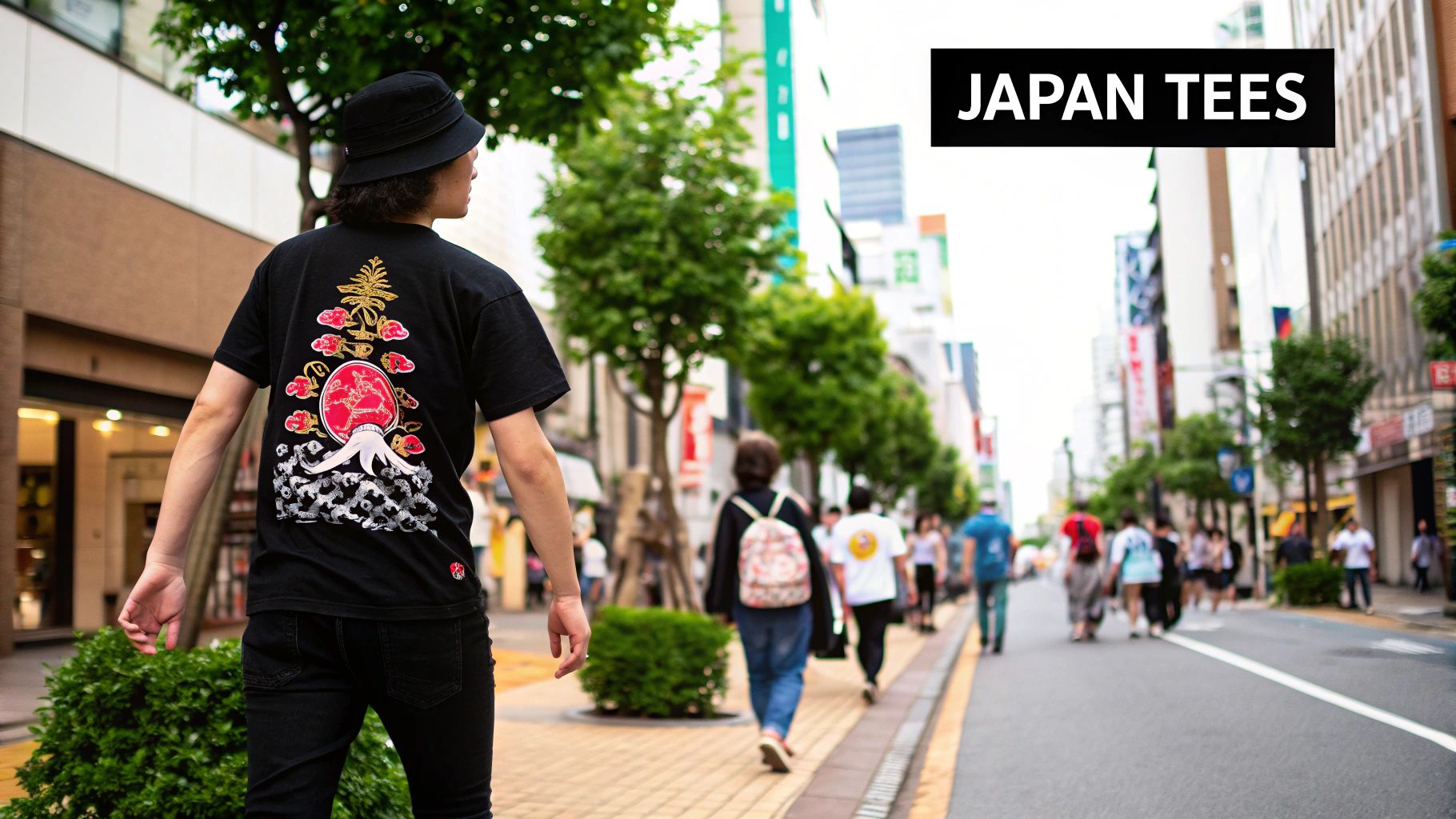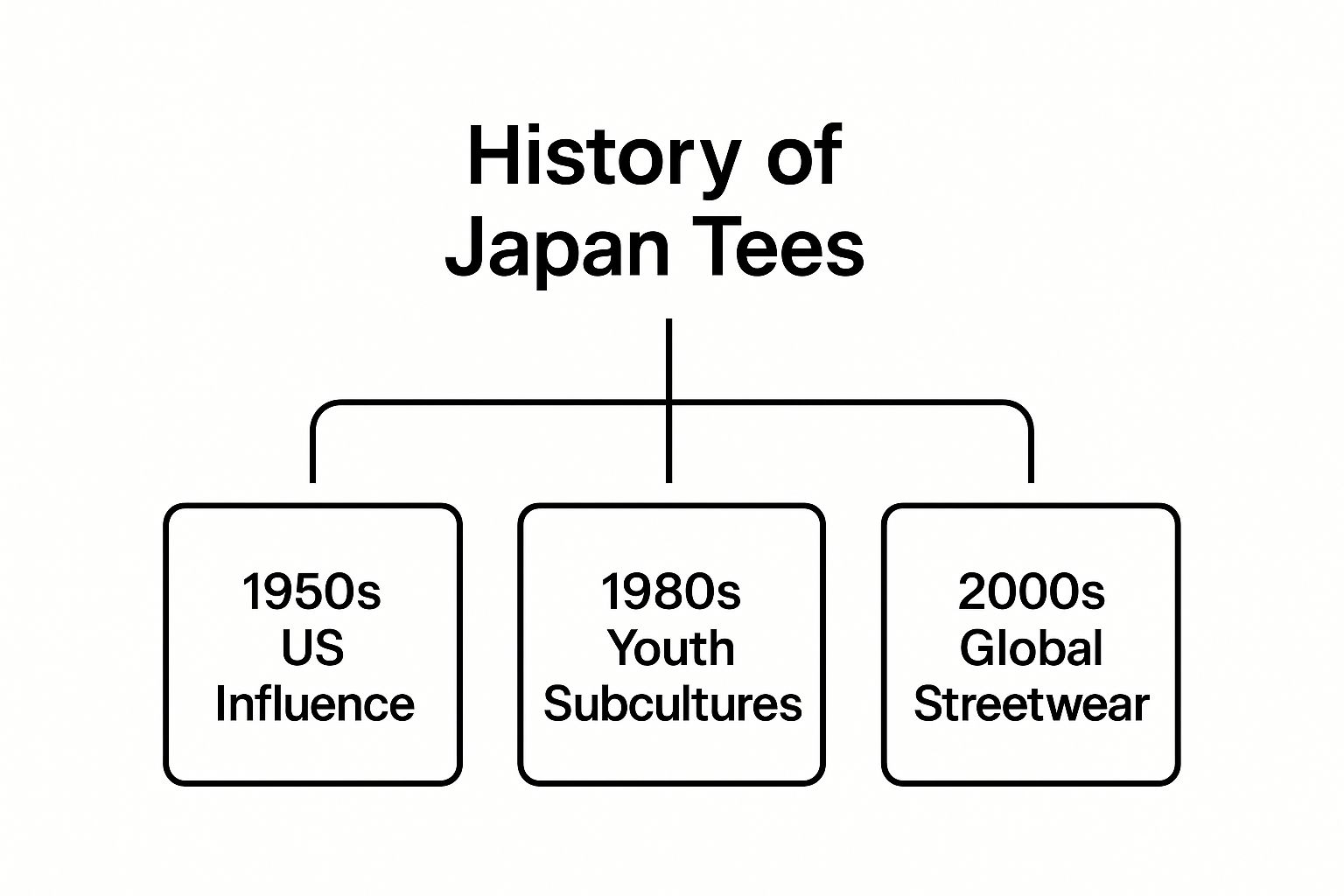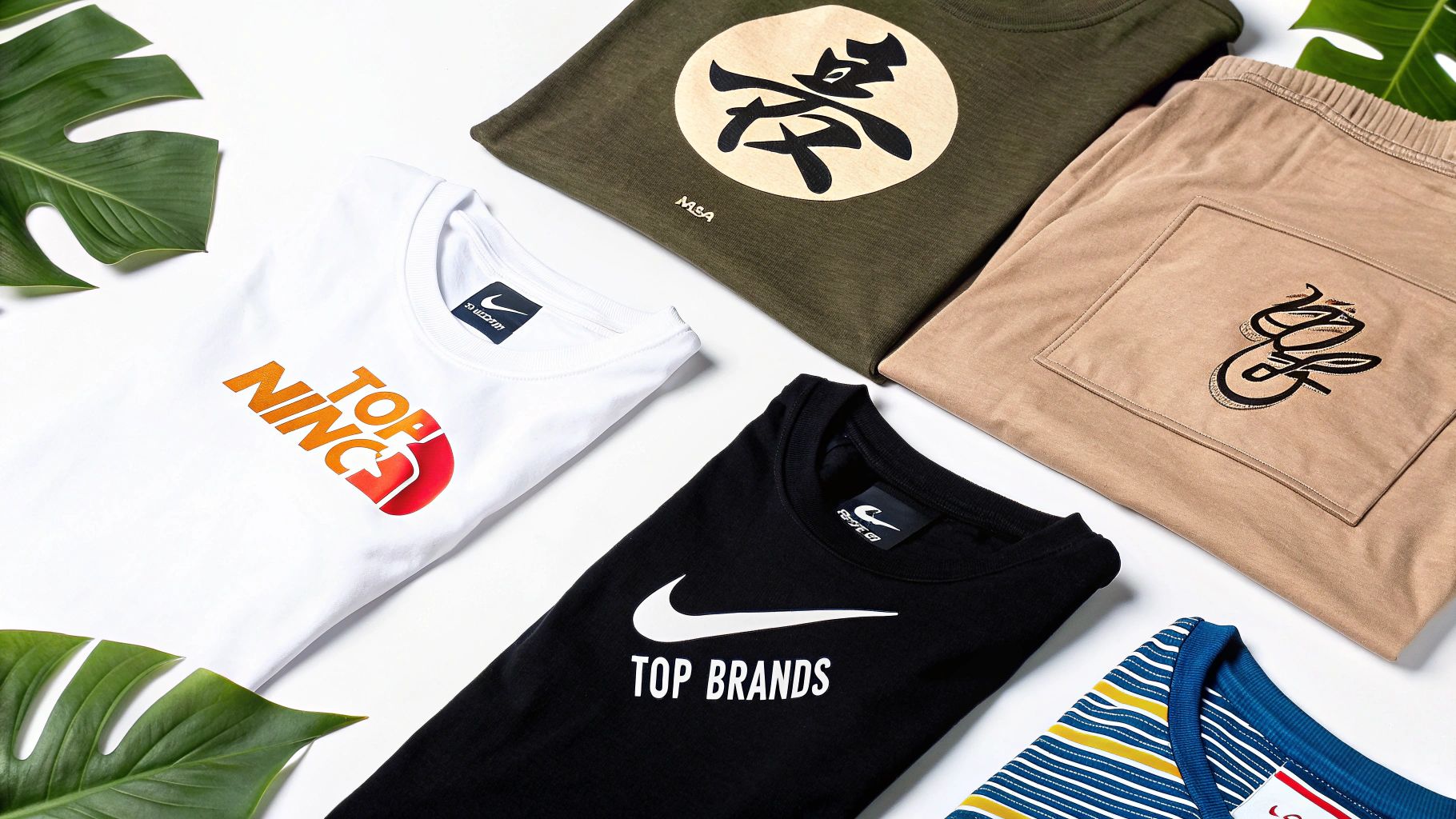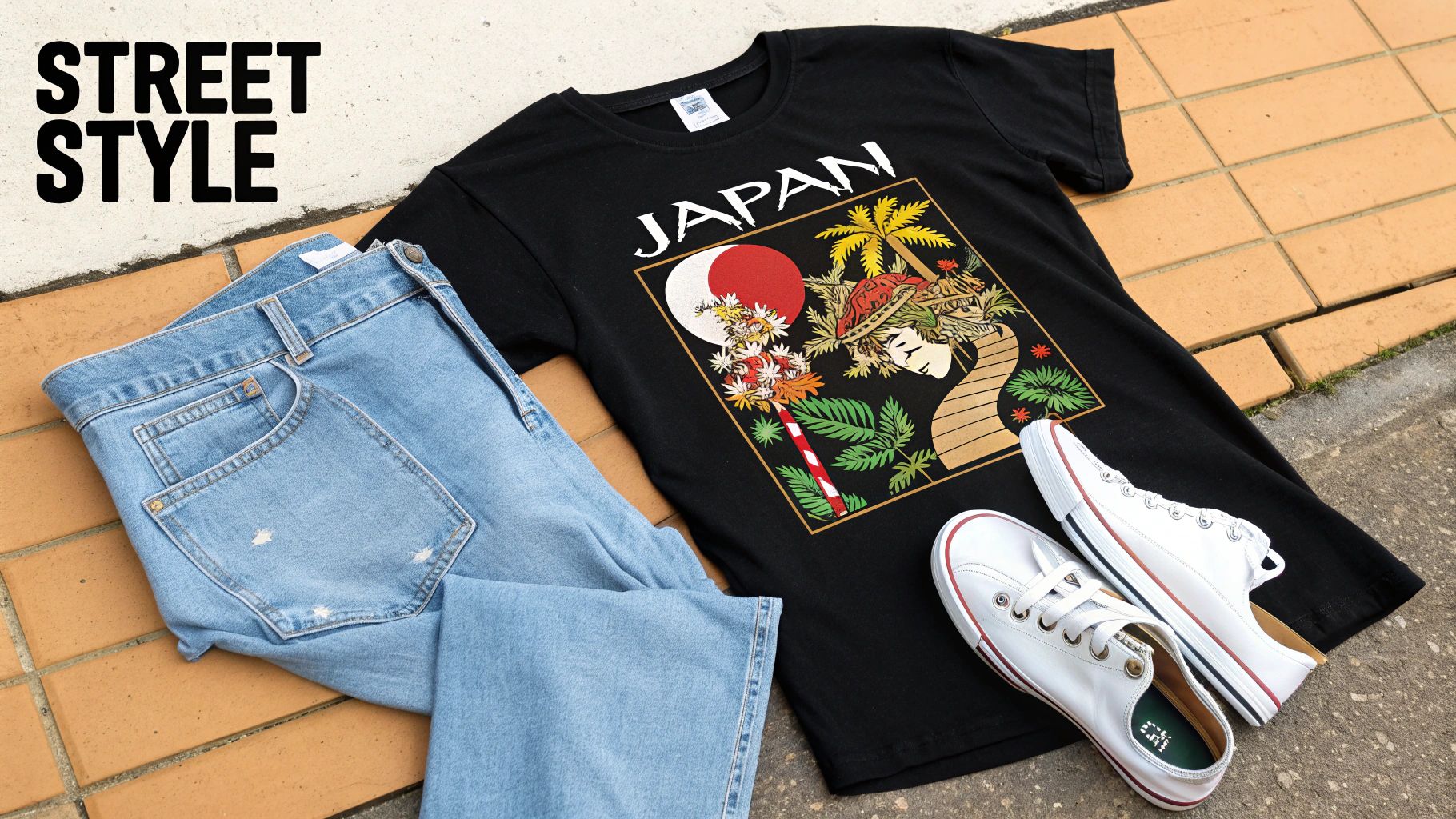
Your Essential Guide to Japan Tees and Streetwear
Share
Japanese t-shirts are way more than just clothes. They're wearable art, capturing the absolute essence of Japanese culture in a way few other garments can. They have this incredible ability to blend rich artistic traditions with the chaos of modern pop culture, which is why they’ve blown up into a global fashion staple.
What's the Deal with Japan Tees, Anyway?

At its heart, a Japan tee is a canvas for telling a story. It’s a way to express a genuine connection to the country's insane aesthetic heritage. The designs pull from literally everything, creating this unique fusion of old and new that just hits differently.
It's a tangible link to a culture, letting you wear your passion on your sleeve—or, well, your chest. These shirts speak a visual language that fans get, no matter where they are in the world.
Take a look through a solid collection of Japanese t-shirts in the UK, and you'll see just how diverse they are. You've got everything from subtle, minimalist motifs to huge, in-your-face graphic statements. Every single shirt is telling a story, whether it's one about ancient myths or neon-drenched futuristic cityscapes.
The Core Influences
So, what makes these tees so compelling? It's their power to mash up completely different artistic styles into one solid, cohesive piece. The main inspirations usually come from a few key places:
- Classic Art: Think iconic imagery from Ukiyo-e woodblock prints, like Hokusai's "The Great Wave," or the raw, elegant brushstrokes of traditional calligraphy.
- Pop Culture: This is where it gets loud. We're talking about the dynamic worlds of anime and manga, bringing beloved characters and epic scenes to life in full, vivid colour.
- Streetwear: A massive influence comes from the bold, anything-goes fashion of Tokyo's Harajuku and Shibuya districts, places known for setting trends, not following them.
Ultimately, these tees are a celebration of artistry and a middle finger to boring fashion. They give you a totally unique way to connect with and show your appreciation for Japanese culture.
Exploring Iconic Japanese T-Shirt Styles
The universe of Japan tees is a wild ride, mashing up centuries of traditional art with modern pop culture and edgy street fashion. These aren't just clothes; they're a visual language. Each design tells a story, and knowing the core styles helps you see the deep cultural roots woven into every thread.
It's a scene that’s always evolving, much like Japan's own cultural exports. This kind of exchange isn't new, either. Japan and the UK have a long history of trade. Way back around 1853, a female merchant named Kei Oura started shipping a unique Japanese tea to the UK. This created an early link between the two island nations that just kept growing. You can dive deeper into this cool history of the tea trade if you're curious.
Ukiyo-e and Traditional Art
A lot of the classic Japan tees you see are inspired by Ukiyo-e, which translates to "pictures of the floating world." These are the iconic woodblock prints from Japan's Edo period (1603-1868), famous for their slick lines and scenes of epic landscapes, historical sagas, and kabuki actors.
Think of Hokusai’s The Great Wave off Kanagawa. When you see that masterpiece on a tee, it’s not just a cool graphic. It's a slice of art history, connecting you to a timeless Japanese vibe. This style often sticks to a limited colour palette to mimic the original printing methods, keeping it authentic.
Anime and Manga Culture
This is probably the style that’s taken over the world. Anime and manga-inspired tees are a straight-up celebration of Japanese pop culture. From legendary series to the latest obsessions, these shirts plaster your favourite characters and epic moments right on your chest. They're like a badge of honour for fans, instantly connecting you to a massive global community that just gets it.

This visual shows how we got here—from the influence of American military fashion in the 1950s, to local youth movements in the 1980s, and the explosion of global streetwear in the 2000s. They all played a part in shaping the modern Japan tee.
Minimalist and Calligraphy Designs
But not all Japan tees are about loud, in-your-face graphics. There’s a whole other world focused on the quiet power of minimalism and Shodo (calligraphy). These designs are all about a single, potent kanji character or a delicate brushstroke.
The magic of this style is in its simplicity and deep meaning. A single character can stand for massive concepts like ‘samurai’ (侍), ‘harmony’ (和), or ‘dream’ (夢). It lets you wear an idea or a value with a clean, understated confidence. These tees are perfect if you want a more sophisticated look that still has that cultural connection.
To give you a clearer picture, here’s a breakdown of some of the most common themes you'll find.
Popular Japan Tee Design Styles
| Style Category | Key Characteristics | Common Imagery |
|---|---|---|
| Traditional/Ukiyo-e | Elegant lines, limited colour palettes, historical feel. | The Great Wave, samurai, geishas, cherry blossoms, dragons. |
| Anime/Manga | Vibrant colours, dynamic characters, bold action scenes. | Iconic characters from series like Naruto, Dragon Ball, or Studio Ghibli films. |
| Minimalist/Calligraphy | Simple, clean aesthetic, focus on a single element. | Single kanji characters, enso circles, subtle nature motifs. |
| Harajuku Streetwear | Experimental, chaotic, bold, often futuristic or abstract. | Glitch art, neon typography, oversized graphics, deconstructed logos. |
| Kawaii/Cute Culture | Adorable, playful, and colourful. | Chibi characters, cute animals like cats and pandas, food items with faces. |
Each category offers a completely different way to tap into Japanese aesthetics, whether you're into ancient art or futuristic chaos.
Harajuku Streetwear
Finally, you've got the bold, avant-garde stuff born on the streets of Tokyo’s legendary Harajuku district. This fashion scene is all about smashing rules and pure self-expression. The tees that come out of it are often abstract, futuristic, or totally deconstructed.
We're talking glitch art, searing neon colours, and typography that looks like it's from another dimension. These designs bottle the chaotic, creative energy of modern Tokyo street style and throw it onto a t-shirt. It’s a powerful statement.
Why Print Quality Makes or Breaks a Design

You can have the most incredible design in the world, but if the print is rubbish, the whole tee is a write-off. Think about it: a blurry, stiff graphic that cracks after one wash completely ruins the vibe. It’s like watching a 4K masterpiece on a tiny, pixelated screen—the soul of the art gets lost.
When we're talking about the delicate lines of a Ukiyo-e woodblock or the explosive energy of an anime scene, the print quality isn't just a detail; it's everything. It’s what turns a simple T-shirt into a piece of wearable art. This obsession with quality is a thread that runs through both traditional Japanese craftsmanship and modern street style.
The DTF Printing Advantage
This is where Direct-to-Film (DTF) printing comes in and completely changes the game. Forget those old-school prints that feel like a thick, plastic sticker. DTF produces graphics that are razor-sharp, ridiculously durable, and have a soft feel that actually blends with the fabric. It’s the perfect tech for handling the complex, multi-coloured designs found on the best Japan tees.
The benefits of DTF printing are impossible to ignore:
- Vibrant, Accurate Colours: It makes colours pop with insane brightness and accuracy. No more dull, washed-out graphics.
- Incredible Durability: These prints are built to survive the wash. They resist the fading and cracking that plagues cheaper tees.
- Soft Feel: DTF prints move with the fabric, so you avoid that stiff, uncomfortable feeling you get from lesser methods.
This technology ensures your tee’s design stays looking as fresh as the day you got it. If you want to get really nerdy about the specifics, we've got a full breakdown comparing DTF vs screen printing for graphic tees.
Investing in a high-quality print means you're not just buying a t-shirt; you're preserving a piece of art. It’s the difference between a throwaway trend and a wardrobe staple that actually says something about you.
This focus on quality and detail isn't just a fashion thing. It mirrors the precision seen everywhere, even in global trade. For instance, Japan's tea import from the United Kingdom was valued at around US$2.58 million in 2024. That’s a niche trade relationship built on a mutual appreciation for specific standards—not unlike our commitment to the perfect print.
Right, so you've got the perfect Japanese tee. The graphic is insane, the fit is on point. But how do you build a whole look around it without looking like you just threw on the first things you found?
A killer tee is the centrepiece, not the whole story. The goal is to let it shine without everything else around it screaming for attention. Let's break down how to nail it, whether you're going for a relaxed Tokyo street vibe or something a bit sharper.
Build a Casual Streetwear Look
This is the natural habitat for a Japanese graphic tee. It’s all about a relaxed, almost effortless silhouette where the T-shirt's art does all the heavy lifting.
Start with the bottoms. Think loose-fit cargo trousers or some proper wide-leg jeans. That slightly baggy silhouette is pure modern streetwear and gives you that comfortable, ready-for-anything feel. On your feet, chunky trainers are a no-brainer—they complete the look and keep it grounded.
Then, it's all about the details:
- A simple beanie adds that touch of understated cool.
- A crossbody bag is non-negotiable. It's practical, sharp, and keeps the whole aesthetic tight.
- Minimalist silver jewellery works best. A single chain or a subtle ring adds a personal touch without fighting the tee for the spotlight.
Create a Smart-Casual Outfit
Think your favourite tee is just for weekends? Think again. With the right layering, you can easily elevate it for a more polished, smart-casual outfit. The trick is to frame the tee with cleaner, more structured pieces.
Chuck a sleek bomber jacket or an unbuttoned overshirt over your tee. Instantly, you've added depth and structure. Pair that combo with some slim-fit dark denim or chinos to create a nice contrast with the casual vibe of the shirt. To finish it off, go for clean, minimalist trainers or even a pair of leather boots.
The whole point here is to treat the T-shirt's graphic like a piece of art. You're using smarter clothing to frame it, creating a look that’s sophisticated but still has that laid-back edge. It proves just how versatile a genuinely well-designed tee can be.
How to Choose a High-Quality Japan Tee

Navigating the world of Japan tees can be a minefield. It's way too easy to get hooked by a killer design, only to end up with a tee that shrinks, fades, or feels like sandpaper after its first encounter with your washing machine. To dodge that bullet, you need to look past the graphic and think like a pro, focusing on the holy trinity of quality: fabric, print, and fit.
Investing in a well-made garment isn't a new idea. Think about the UK's long-standing appreciation for quality goods from Japan. Tea first landed on British shores from China and Japan back in the 1600s, quickly becoming a luxury item treasured for its superior quality. This whole trade relationship was built on having a discerning eye, a principle that still holds true when you’re picking out your next tee. You can dive deeper into the fascinating history of the tea trade on rmg.co.uk.
Inspect the Fabric and Print
The foundation of any great T-shirt is the material it's made from. You want to be on the lookout for garments made from 100% combed or ringspun cotton. These are worlds away from standard cotton—they’re softer, stronger, and just feel better. While a cotton-poly blend can hold its shape well, nothing beats the breathability and premium feel of high-grade cotton against your skin.
Next, get your eyes on the print itself. A quality DTF print should be sharp, with clean lines and no fuzzy bleeding between the colours. It should feel like it's part of the fabric, not a thick, plastic sticker just sitting on top. If the print looks blurry or feels stiff and crackly, that’s a massive red flag for a cheap, mass-produced job that won’t survive the long haul. If you're looking to make your own, getting familiar with custom T-shirt printers can give you a serious edge.
Pay attention to the small stuff. Quality is often hidden in the stitching around the collar and seams. Look for clean, tight, and consistent work—uneven or loose threads are a dead giveaway of a poorly made garment.
Get the Sizing Right
Finally, don't sleep on the fit. Sizing can be a bit of a lottery, especially between Japanese and Western brands. Japanese sizes often run smaller and might have a slimmer, more tailored cut.
- Always check the size chart: Don't just assume your usual size will work. Grab a tape measure, find your favourite tee at home, and compare its measurements to the brand's chart.
- Think about the intended fit: Are you going for that classic, fitted look, or are you chasing the relaxed, oversized silhouette that’s all over modern streetwear?
- Read customer reviews: This is gold. Previous buyers will often tell you straight up if a tee fits true to size, runs small, or is bigger than expected.
By keeping these key points in mind, you can make sure you’re not just buying a T-shirt, but investing in a quality piece that looks incredible and is built to last.
FAQs About Japan Tees
Diving into the world of Japanese-inspired tees can throw up a few questions, especially around what makes them legit, how to care for them, and how the sizing works. Nailing these details is the secret to building a collection you'll actually wear.
So, what even is a "Japan tee"? It’s way more than just a t-shirt made in Japan. It’s a piece of clothing that wears its Japanese cultural roots on its sleeve—literally. Think traditional Ukiyo-e woodblock art, bold calligraphy, or modern chaos from anime, manga, and Harajuku street fashion. The soul of the shirt is in the art it carries.
How Do I Look After My Graphic Tee?
If you want your Japan tees to stay looking sharp, you need to treat them right. The goal here is simple: be gentle. You want to protect the print and the fabric to give it the longest life possible.
Here are a few tips that actually work:
- Wash It Inside Out: This is non-negotiable. Always flip your tee inside out before it hits the machine. This puts a barrier between the print and every other piece of clothing (and the machine drum itself), saving it from getting scuffed up.
- Go Cold: Hot water is the enemy of graphic prints. It breaks down the ink and can shrink the cotton. Stick to a cold wash on a gentle cycle. Your tee will thank you for it.
- Air Dry If You Can: Tumble dryers are brutal. The high heat can crack, fade, and peel the print right off. Hang your tee up to air dry. It’s the single best thing you can do to keep it looking fresh.
Follow these simple rules, and the vibrant colours and crisp details on your shirt will last for years, not just a few washes. It’s a tiny bit of effort for a long-lasting piece of wearable art.
Will Japanese Sizing Even Fit Me?
Sizing is probably the biggest headache. Japanese brands often follow a completely different sizing standard to what we're used to in the UK or US, and it can be a bit of a gamble.
As a general rule of thumb, Japanese sizes usually run about one size smaller.
So, if you’re normally a Medium in the UK, you’ll likely need a Large from a Japanese brand to get a similar fit. But don't just guess. The best thing you can do is check the specific brand's size chart. Seriously. Grab a t-shirt you already own that fits perfectly, measure it, and compare those numbers to the chart on the product page. It's the only way to guarantee you won't be disappointed.
